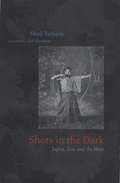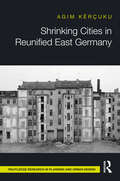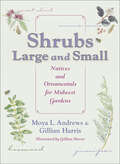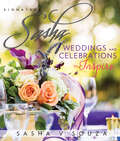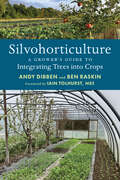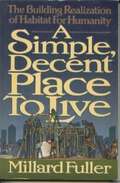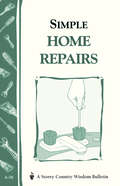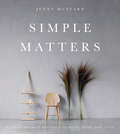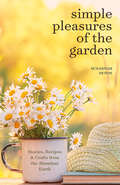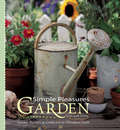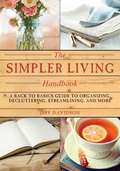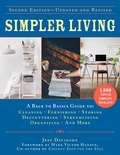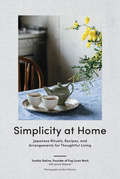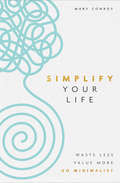- Table View
- List View
Shop Tools
by Deere CompanyTools don't make the service technician - but they help. Knowing how to use and care for them will put you a step ahead of the crowd. In this book, we'll cover the following tools: Screwdrivers, Hammers, Pliers, Wrenches, Chisels, Punches, Files, Hacksaws, Vises, Clamps, Twist Drills, Taps and Dies, Screw Extractors, Pullers, Pick-Up Tools, Inspection Mirrors, Tubing Cutters, Soldering Equipment, Feeler Gauges, Micrometers, Dial Indicators, Spring Testers, Pressure Gauges, Speed-Measuring Tools
Shots in the Dark: Japan, Zen, and the West
by Shoji Yamada Earl Hartman S. YamadaIn the years after World War II, Westerners and Japanese alike elevated Zen to the quintessence of spirituality in Japan. Pursuing the sources of Zen as a Japanese ideal, Shoji Yamada uncovers the surprising role of two cultural touchstones: Eugen Herrigel's Zen in the Art of Archery and the Ryoanji dry-landscape rock garden. Yamada shows how both became facile conduits for exporting and importing Japanese culture.
Shrinking Cities in Reunified East Germany
by Agim KërçukuThe book explores the relationship between the shrinking process and architecture and urban design practices. Starting from a journey in former East Germany, six different scenes are explored in which plans, projects, and policies have dealt with shrinkage since the 1990s. The book is a sequence of scenes that reveals the main characteristics, dynamics, narratives, reasons and ambiguities of the shrinking cities’ transformations in the face of a long transition. The first scene concerns the demolition and transformation of social mass housing in Leinefelde-Worbis. The second scene deals with the temporary appropriation of abandoned buildings in Halle-Neustadt. The third scene, observed in Leipzig, shows the results of green space projects in urban voids. The scene of the fourth situation observes the extraordinary efforts to renaturise a mining territory in the Lausitz region. The fifth scene takes us to Hoyerswerda, where emigration and ageing process required a reduction and demolition in housing stock and social infrastructures. The border city of Görlitz, the sixth and last scene, deals with the repopulation policies that aim to attract retirees from the West.
Shrubs Large and Small: Natives and Ornamentals for Midwest Gardens
by Gillian Harris Moya L. AndrewsA charming and colorful guide to the hardy, low-maintenance plants that serve as essential elements of the architecture of our gardens.This beautifully illustrated book on landscape gardening addresses shrubs and how to determine which you should plant among your perennials and where. Shrubs provide the foundation for a pleasing, yet low-maintenance garden. They are long-lived, have the ornamental appeal of perennials, and provide variety in color, size, shape, and texture, as well as shelter and berries for birds. Shrubs can make attractive arrangements indoors and provide seasonal variation through the entire year.In addition to the useful information for gardeners of any skill level, Shrubs Large and Small includes Gillian Harris’s irresistible illustrations—botanically correct works of art that will delight and inspire.
Shrubs: Discover the Perfect Plant for Every Place in Your Garden
by Andy McIndoeA Shrub for Every Situation Shrubs are the perfect plant—they are low-maintenance, there is a variety for nearly every need, and they are widely available at garden centers and nurseries. In his new book Shrubs, Andy McIndoe—one of the world’s foremost woody plant experts—offers the information and advice needed to pick the right shrub for every site and condition. Shrubs includes plant suggestions for challenging growing conditions and restricted planting spaces, along with shrubs chosen for their desirable characteristics, including hardiness in shade, difficult soil, and harsh conditions. Every plant profile includes complete growing information, color photographs, and recommended companion plants. With this helpful guide in hand, it’s easier than ever to decide which shrubs to add to your home garden.
Signature Sasha: Weddings and Celebrations to Inspire (Signature Sasha)
by Sasha V. SouzaAuthored by internationally recognized event designer Sasha Souza, Weddings & Celebrations to Inspire, is Souza’s much anticipated second event design book. Featuring images from many of Souza’s beautiful events, Weddings & Celebrations to Inspire offers event inspiration, practical advice, design ideas, design-your-own suggestions and directions, color palettes, real wedding and celebration images and descriptions, and other party tips for both the party throwing layman and event industry professionals. Weddings & Celebrations to Inspire provides helpful commentary and visual aid to help you design your next small to large, casual to formal, or simple to sophisticated celebration.
Silvohorticulture: A grower's guide to integrating trees into crops
by Andy Dibben Ben Raskin"Dibben and Raskin offer an insightful, inspiring but also exceptionally practical guide to integrating trees into annual cropping systems. . . in this book we see how the phrase 'the sky’s the limit' has never been more applicable."—Jesse Frost, author of The Living Soil Handbook An invaluable handbook for farmers, growers, and gardeners, Silvohorticulture is the first book to offer a detailed, practical guide on how to effectively integrate trees with vegetable growing, offering information previously known only in the foresting world. Drawing on the decades-long experiences of Ben Raskin and Andy Dibben, both of whom have designed and managed agroforestry systems and have extensive experience in commercial horticultural crop production, this is the definitive book on the interaction between trees and crops, covering the benefits of trees for edible crops and the potential for additional crops from trees, plus crucial new information on how to fit trees into complex crop rotations as well as manipulating access to light. Ben and Andy also reveal the latest research on how tree roots behave and, importantly, how that impacts your crops. Agroforestry can bring immense benefits to farmers and growers—not just optimizing yield, but also improving soil, managing pests and water, increasing biodiversity, and reducing costs. System design must be customised to each grower’s requirements, and Silvohorticulture offers step-by-step detail that will allow you to manage your trees and crops successfully. "In this immensely practical guide, the authors provide the technical details towards integrating trees with vegetables and other crops, all while dispelling any preconceived notions that this idea reduces productivity or function. In fact, these systems might prove essential for farm resilience in a changing climate."—Steve Gabriel, author of Silvopasture
Silvohorticulture: A grower's guide to integrating trees into crops
by Andy Dibben Ben Raskin"Dibben and Raskin offer an insightful, inspiring but also exceptionally practical guide to integrating trees into annual cropping systems. . . in this book we see how the phrase 'the sky&’s the limit' has never been more applicable."—Jesse Frost, author of The Living Soil HandbookAn invaluable handbook for farmers, growers, and gardeners, Silvohorticulture is the first book to offer a detailed, practical guide on how to effectively integrate trees with vegetable growing, offering information previously known only in the foresting world.Drawing on the decades-long experiences of Ben Raskin and Andy Dibben, both of whom have designed and managed agroforestry systems and have extensive experience in commercial horticultural crop production, this is the definitive book on the interaction between trees and crops, covering the benefits of trees for edible crops and the potential for additional crops from trees, plus crucial new information on how to fit trees into complex crop rotations as well as manipulating access to light. Ben and Andy also reveal the latest research on how tree roots behave and, importantly, how that impacts your crops.Agroforestry can bring immense benefits to farmers and growers—not just optimizing yield, but also improving soil, managing pests and water, increasing biodiversity, and reducing costs. System design must be customised to each grower&’s requirements, and Silvohorticulture offers step-by-step detail that will allow you to manage your trees and crops successfully."In this immensely practical guide, the authors provide the technical details towards integrating trees with vegetables and other crops, all while dispelling any preconceived notions that this idea reduces productivity or function. In fact, these systems might prove essential for farm resilience in a changing climate."—Steve Gabriel, author of Silvopasture
Simple Acts to Save Our Planet: 500 Ways to Make a Difference (Simple Acts Gift Series)
by Michelle NeffSimple Acts to Save Our Planet shows you how to be more active in saving our planet every day by performing some &“Simple Acts of Kindness&”—for the Earth.Treat the environment with kindness with these easy, manageable activities that range from simple home updates, to gardening basics, to supporting the local community. You&’ll learn simple techniques to help protect the planet every day, like starting a compost pile to reduce food waste, utilizing travel mugs and reusable containers, and choosing eco-friendly products. By working to implement these simple strategies into your everyday life, you can take an active stand to protect the environment now— and make a real difference for the future.
Simple Decent Place to Live: The Building Realization of Habitat for Humanity
by Millard FullerReaders will be moved by this exciting story of real-life good Samaritans in this uplifting story of Habitat for Humanity. Fuller tells how he came to be touched with the needs of others for affordable housing. He incorporates testimonies from celebrities--Jimmy Carter, Tom Brokaw, Paul Newman and others--who tell what Habitat for Humanity means to them.
Simple Farmhouse Life: DIY Projects for the All-Natural, Handmade Home
by Lisa BassTransform your home into a simple farmhouse--no matter where you live--with this beautiful guide to slow living. Country girl and popular blogger Lisa Bass shares her favorite hearty recipes, handmade projects, and tips for natural living that she uses in her own from-scratch life. Slow down and enjoy the simplicity of a country lifestyle with recipes and projects such as: Natural Kitchen: rosemary lemon foaming dish soap, stonewashed linen apron, market toteHandmade Décor: pillow covers from reclaimed materials, dipped beeswax candles, linen ruffle throw blanketNatural Body: chamomile body butter, lavender calendula salve, relaxing bath soak and body mistNatural Laundry: essential oil spot remover, wool dryer balls, lavender linen sprayNatural Cleaning: orange dusting spray, glass cleanerFarmhouse Cooking: cast iron sourdough cinnamon roll, orange cream kefir smoothie, roasted red pepper and tomato soupGardening: windowsill herb garden, cut flower garden, essential oil pest spray
Simple Green Pest and Disease Control: Bob's Basics (Bob's Basics)
by Bob FlowerdewOne of the biggest challenges of growing an organic garden is keeping away pests and diseases without using harmful pesticides. But as Bob illustrates in this necessary guide for any organic gardener, it is possible to keep your garden chemical-, pest-, and disease-free all at once. A master at growing organic produce, Flowerdew outlines the best natural methods, from building effective physical barriers and pest traps out of plants and recycled materials to using such natural pest predators as birds, reptiles, and even other bugs.
Simple Home Repairs: Storey's Country Wisdom Bulletin A-28 (Storey Country Wisdom Bulletin Ser.)
by Editors of Storey PublishingSince 1973, Storey's Country Wisdom Bulletins have offered practical, hands-on instructions designed to help readers master dozens of country living skills quickly and easily. There are now more than 170 titles in this series, and their remarkable popularity reflects the common desire of country and city dwellers alike to cultivate personal independence in everyday life.
Simple Knits: 12 Easy-Knit Projects for Your Home (Simple Knits)
by Claire CromptonPatterns for the coziest and cutest cushions, seating cubes, and pillows from the established designer and bestselling author of The Knitter&’s Bible. Featuring strong designs across a range of styles for the new-to-knitting market, all the projects included are either Beginner, Easy or Intermediate skill level, and the majority are Easy. As well as patterns and project instructions, you will also find an explanation of the abbreviations used, a knitting needle conversion chart, a skill level key, a standard yarn weight chart, knitting techniques and making-up techniques. Projects include: · Pompom Cushion · Bright Stripe Pillows · Beaded Cushions · Black and White Pillow · Vibrant Seating Cube · Fringed Ribbon Pillow · French Knitted Cushions · Blooming Rose Pillow · Diamond Pattern Pillow · Bunting Cushion
Simple Matters: A Scandinavian's Approach to Work, Home, and Style
by Jenny MustardSimplify your home, health, and lifestyle with the help of Scandinavian minimalist sensation, Jenny Mustard.In a beautiful collection of essays, Simple Matters challenges readers to simplify their life by prioritizing emotional and physical health, curating a personal style, and pursuing one’s dreams.Jenny Mustard has created a unique lifestyle book that taps into the ever-increasing human longing for less clutter and more meaning, be it at home, at work, or in our relationships. By encouraging readers to make their surroundings a little more lovely, to simplify eating habits and wardrobe, to travel with purpose and ease, and to discover what they truly want to dream about and focus on, Jenny provides the inspiration to curate one’s everyday life into something simple, realistic, and utterly enjoyable.Simultaneously inspirational and aspirational, Jenny’s content is positive, personal, and inclusive—42 essays cover everything from simple kitchen staples, the art of the travel plan, indulgent eating, addiction, failure as a road to success, the makings of a happy relationship, the red thread, building a career, and the Scandinavian way at home.
Simple Pleasures of the Garden: Stories, Recipes & Crafts from the Abundant Earth (Simple Pleasures Ser.)
by Susannah SetonSimple Pleasures Throughout the Year “Simple Pleasures has become my go-to book for remembering to slow down and enjoy the little things in life.” —Becca Anderson, bestselling author of Badass Affirmations, The Book of Awesome Women, and moreAn abundant sourcebook of ideas, encouraging quotes, recipes, and soothing activitiesSimple Pleasures of the Garden shows you how to appreciate the simple things within your daily activities. The secret to living well year round can be found in the abundance of your home garden, so get to planting those seeds of simple joys and herbal healing! Nurture your mind, body, and soul. Sometimes finding the positive can be hard, but it doesn’t have to be. From the recipe for a homemade herbal bath for a spa day to quick and easy recommendations for an instant room makeover, the suggestions and home recipes collected in this book offer a new appreciation for the everyday activities that nurture and comfort you.Simplify your emotional self care. Taking care of yourself doesn’t have to be expensive, unrealistic, or inaccessible. It can be as easy as tending to a green garden, making healing herbal tonics, sipping calming teas, or spending time with other natural energy boosters. Pleasures are made, not bought, so unlock new secrets to happiness with these touching stories, practical tips, and satisfying crafts. Inside this positive attitude book you’ll find: Ways to decorate your home with nature crafts, growing herbs, and an air of magic Advice on how to foster a routine for a rejuvenating self care yearTips on how to become the gardener of your moods and emotionsIf you liked seasonal self care books like A Year of Self-Care, Grow Your Own Medicine, or A Woman’s Garden, you’ll love Simple Pleasures of the Garden.
Simple Pleasures of the Garden: Stories, Recipes & Crafts from the Abundant Earth (Simple Pleasures Series)
by Susannah SetonA collection of gardening tips, recipes, crafts, gift ideas, tales, and more from the author of Every Garden Is a Story.Simple Pleasures of the Garden is a treasure chest of tips, how-to&’s, stories, and trade secrets gathered together in one beautiful book. Organized by season, the hundreds of suggestions and recipes present a profusion of ways to celebrate the bounty of the Earth all year round. Projects include handcrafted lotions and oils, baskets and wreaths, potpourris and floral waters, along with dozens of simple, inexpensive home decorations and easy-to-prepare recipes that utilize all of your garden&’s harvest. From compost tea to confetti corn chowder, Simple Pleasures of the Garden will inspire you to bestow the comforts and charms of your garden on family and friends.
Simple Pleasures of the Home: Comforts and Crafts for Living Well (Simple Pleasures Series)
by Susannah SetonA room-by-room guide to creating domestic bliss.Home—it’s the place where we can let down our hair, loosen our clothes, put our feet up. It’s where those we love most share in the ordinariness and extraordinariness of our days. It’s where many of us spend lifetimes trying to get back to. As the proverb goes, it’s where our hearts are.Simple Pleasures of the Home is for everyone who has the nesting impulse—from passionate and accomplished home decorators to anyone who simply enjoys domestic downtime. Organized room by room, the book includes dozens of:Simple activities for bringing the family togetherCreative ideas for pampering yourself and loved onesEasy-to-follow instructions for making aromatherapy productsTips for candlemakingComfort-food recipes, and more
Simple Pleasures of the Kitchen: Recipes, Crafts & Comforts from the Heart of the Home
by Susannah SetonA collection of recipes, crafts, and activities to bring your family together in the kitchen, from the author of Simple Pleasures of the Garden. The kitchen really is the heart of the home. It&’s the first place family and friends gather, not only to prepare and eat food, but to chat, sip tea, snack on home-baked cookies, unwind after a tough day, and reconnect with loved ones. The latest in the Simple Pleasures series of books, Simple Pleasures of the Kitchen captures the essence of the kitchen. It offers a cornucopia of recipes, food-based crafts, food facts and tips, and family activities, as well as stories from kitchens around the world sure to warm anyone&’s heart, no matter what the weather. Organized by season, the book offers: Spring Flings, The Savor of Summer, Autumn&’s Abundance, and Cozying Up in Winter. Recipes include comforting mashed potatoes, fresh summer risotto, delicious meatloaf, and heart-warming brownies and popovers. The super-simple jam recipe will go great with popovers, or as a gift in jars you&’ve decorated yourself. You can satisfy your sweet tooth and your soul at the same time! Susannah Seton&’s Simple Pleasures books continually delight readers with their down-home recipes, crafts, and activities that bring the whole family together. Don&’t miss this one.&“This enchanting and entertaining book reminds us of the importance of these times, how the simplest of events and day-to-day activities all blend to create cherished memories.&”—Jonathon King, cofounder of Stonewall Kitchen, from the Introduction
Simpler Living Handbook: A Back to Basics Guide to Organizing, Decluttering, Streamlining, and More
by Jeff DavidsonThe ultimate guide to streamlining your life.Life moves too quickly these days, as technology, work, and personal commitments make it almost impossible to relax and enjoy life. Finding yourself stressed over the clutter in your kitchen or the mass of paper in front of your computer? Relax. This book will help. Filled with tips on how to uncomplicate your daily routine, eliminate stress at home and work, and more, this book will help you free up your time so you can once again enjoy doing the things you love. Author Jeff Davidson has compiled more than 1,500 ways to simplify your life.Divided into sections for easy reference, this book will show you ways you can eliminate stress in your home, your personal life, and your professional life. You will learn the six questions you should ask yourself before buying something new, the most efficient way to clean your pots and pans, the pay-ahead technique to get yourself out of debt, ways to make your commute more comfortable, and advice on hassle-free vacation planning for you and your family. Simpler Living Handbook is the guide you've been looking for to lead the peaceful, productive life you've always wanted.
Simpler Living, Second Edition—Revised and Updated: A Back to Basics Guide to Cleaning, Furnishing, Storing, Decluttering, Streamlining, Organizing, and More (Back to Basics Guides)
by Jeff Davidson1,500 Ways to Declutter, Organize, Streamline, and Reclaim Your Space and Your Time! Life moves too quickly these days, as technology, work, and personal commitments make it almost impossible to relax and enjoy life. Finding yourself stressed over the clutter in your kitchen or the mass of paper in front of your computer? Relax. This book will help. Filled with tips on how to uncomplicate your daily routine, eliminate stress at home and work, and more, this book will help you free up your time and your space so you can once again enjoy doing the things you love. Author Jeff Davidson has compiled more than 1,500 ways that you can simplify your life. Divided into sections for easy reference, this book will show you ways you can eliminate stress in your home, your personal life, and in your professional life. You will learn the six questions you should ask yourself before buying something new, the most efficient way to clean your pots and pans, the pay-ahead technique to get yourself out of debt, ways to make your commute more comfortable, and advice on hassle-free vacation planning for you and your family. This book is the guide you&’ve been looking for to lead the peaceful, productive life you&’ve always wanted.
Simpler Living: A Back to Basics Guide to Cleaning, Furnishing, Storing, Decluttering, Streamlining, Organizing, and More
by Mark Victor Hansen Jeff DavidsonLife moves too quickly these days, as technology, work, and personal commitments make it almost impossible to relax and enjoy life. Finding yourself stressed over the clutter in your kitchen or the mass of paper in front of your computer? Relax. This book will help. Filled with tips on how to uncomplicate your daily routine, eliminate stress at home and work, and more, this book will help you free up your time so you can once again enjoy doing the things you love. Author Jeff Davidson has compiled more than 1,500 ways that you can simplify your life. Divided into sections for easy reference, this book will show you ways you can eliminate stress in your home, your personal life, and in your professional life. You will learn the six questions you should ask yourself before buying something new, the most efficient way to clean your pots and pans, the pay-ahead technique to get yourself out of debt, ways to make your commute more comfortable, and advice on hassle-free vacation planning for you and your family. This book is the guide you've been looking for to lead the peaceful, productive life you've always wanted.
Simplicity at Home: Japanese Rituals, Recipes, and Arrangements for Thoughtful Living
by Yumiko SekineA gorgeous guide to creating a beautiful, comfortable home based on Japanese traditions from the founder of the beloved lifestyle brand Fog Linen Work.For anyone who dreams of a home filled with well-organized closets, eye-catching flower arrangements, perfectly draped blankets, and thoughtfully curated shelves, here is a guide to cultivating an elegant home.Yumiko Sekine, founder of the internationally celebrated lifestyle brand Fog Linen Work, shares lovely rituals and simple techniques based on Japanese traditions, including practices for decorating, organizing, preparing food, and more. From the kitchen to the bedroom and every space in between, here are tips for refreshing a home each season—arranging and displaying fresh flowers in spring, choosing the right sheets and linens for summer, taking warm herbal baths in autumn, and draping blankets and layering rugs to cozy up a space for winter. Brimming with easy-to-follow tips for elevating any space and packed with hundreds of photographs showcasing gorgeous interiors, this book is an invitation to create a home that nourishes, rejuvenates, and inspires—all year long.• CELEBRATED AUTHOR: Yumiko Sekine is the founder of Fog Linen Work, a Japanese home goods brand sold throughout the world and beloved by home cooks, interior decorators, and design enthusiasts. Her products are known for their simplicity, beauty, and ability to elevate any space. In this book, Sekine distills all her secrets to creating a home that exudes simple elegance.• ORGANIZATION MADE EASY: This book gives readers easy, elegant ways to declutter their homes and organize their belongings, whether they live in an apartment or house, and includes simple tips for tidying and curating objects to bring order and simplicity to every room.• JAPANESE TRADITIONS: Yumiko presents Japanese traditions for preparing food, arranging flowers, entertaining, organizing, and more. The combination of ancient practices and modern techniques makes this the perfect companion for anyone curious about Japanese culture and aesthetics.• GIFT WORTHY: Presented in a linen-wrapped case and brimming with hundreds of gorgeous photographs and inspired advice for every home, this book is a perfect addition to any bookshelf and a lovely gift for new homeowners, newlyweds, and fans of organization and interior design.Perfect for:• Interior designers, minimalists, and fans of sustainability• People who are into organizing their space• Fans of Fog Linen Work
Simplify Your Life: Waste Less, Value More, Go Minimalist
by Mary ConroyMinimalism is for rich people who live in big, empty, white homes, right? Wrong. Minimalism can be a beautiful, enriching and life-transforming practice that, at its core, is all about re-establishing what holds value in your life and letting go of what does not. It's not about having your groceries displayed in glass jars or having chic, Scandinavian furniture - it's a way of life that allows us to strip away the clutter that stands in the way of us achieving our goals. Simplify Your Life is about exactly that: bringing simplicity back into your life, and with it, joy in the everyday. Dispelling the myths that minimalism is for either hardcore environmentalists or the privileged few, this book shows how minimalism is more relevant and necessary than ever, not least because it's the most accessible way to achieve a state of contentment in all aspects of life. Minimalism is for you if you want to: • stop mindlessly scrolling and start living with intention and purpose • spend more time on the things and people you love and less on what you "have to be/do" • take control of your finances and stop mindless spending • learn more about conscious consumption and reducing your waste • experience freedom and pride in your home instead of feeling trapped by your stuffAlthough minimalism is ostensibly about taking things away from our cluttered lives, it is really about adding richness, color, and meaning to our lives. It's about identifying the aspects of our life that we truly love and that nourish us. It's about trusting ourselves and leading the life we always wanted.

